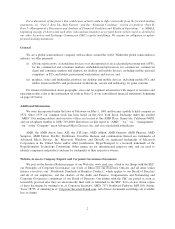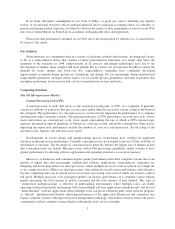AMD 2012 Annual Report Download - page 19
Download and view the complete annual report
Please find page 19 of the 2012 AMD annual report below. You can navigate through the pages in the report by either clicking on the pages listed below, or by using the keyword search tool below to find specific information within the annual report.protect their inventory of our products against price reductions and provide return rights with respect to any
product that we have removed from our price book that is not more than twelve months older than the
manufacturing code date. In addition, some agreements with our distributors may contain standard stock rotation
provisions permitting limited levels of product returns.
AIB Manufacturers and System Integrators
We strive to establish and broaden our relationships with AIB manufacturers. We offer component-level
graphics and chipset products to AIB manufacturers who in turn build and sell board-level products using our
technology to system integrators, or SIs, and at retail. Our agreements with AIBs protect their inventory of our
products against price reductions. We also sell directly to our SI customers. SIs typically sell from positions of
regional or product-based strength in the market. They usually operate on short design cycles and can respond
quickly with new technologies. SIs often use discrete graphics solutions as a means to differentiate their products
and add value to their customers.
Competition
Generally, the IC industry is intensely competitive. Products typically compete on product quality, power
consumption (including battery life), reliability, speed, performance, size (or form factor), cost, selling price,
adherence to industry standards (and the creation of open industry standards), software and hardware
compatibility and stability, brand recognition, timely product introductions and availability. Technological
advances in the industry result in frequent product introductions, regular price reductions, short product life
cycles and increased product capabilities that may result in significant performance improvements. Our ability to
compete depends on our ability to develop, introduce and sell new products or enhanced versions of existing
products on a timely basis and at competitive prices, while reducing our costs.
Competition in the Microprocessor Market
Intel Corporation has dominated the market for microprocessors for many years. Intel’s market share,
margins and significant financial resources enable it to market its products aggressively, to target our customers
and our channel partners with special incentives, and to discipline customers who do business with us. These
aggressive activities have in the past and are likely in the future to result in lower unit sales and a lower average
selling price for our products and adversely affect our margins and profitability.
Intel exerts substantial influence over computer manufacturers and their channels of distribution through
various brand and other marketing programs. As a result of Intel’s dominant position in the microprocessor
market, Intel has been able to control x86 microprocessor and computer system standards and benchmarks and to
dictate the type of products the microprocessor market requires of us. Intel also dominates the computer system
platform, which includes core logic chipsets, graphics chips, motherboards and other components necessary to
assemble a computer system. Original Equipment Manufacturers (OEMs), that purchase microprocessors for
computer systems are highly dependent on Intel, less innovative on their own and, to a large extent, are
distributors of Intel technology. Additionally, Intel is able to drive de facto standards for x86 microprocessors
that could cause us and other companies to have delayed access to such standards.
Intel has substantially greater financial resources than we do and accordingly spends substantially greater
amounts on marketing and research and development than we do. We expect Intel to maintain its dominant
position and to continue to invest heavily in marketing, research and development, new manufacturing facilities
and other technology companies. To the extent Intel manufactures a significantly larger portion of its
microprocessor products using more advanced process technologies, or introduces competitive new products into
the market before we do, we may be more vulnerable to Intel’s aggressive marketing and pricing strategies for
microprocessor products.
11
























